Question Bank 3question bank PDF

| Title | Question Bank 3question bank |
|---|---|
| Author | Kundan Singh |
| Course | Value Engineering |
| Institution | University of Delhi |
| Pages | 6 |
| File Size | 126.7 KB |
| File Type | |
| Total Downloads | 79 |
| Total Views | 163 |
Summary
all ...
Description
Fill in the Blank 1. (Value) ________ is our participation at different levels in the larger order. 2. When we participate in the larger order, this participation at different levels is our (Value) ________. 3. The participation of the human being is seen in two forms: (Behaviour) _______ and (work) ______. 4. (Values) ______ are the outcome of (Realization) ________ and (understanding) ______, which are always definite. 5. By exploring our svatva and living accordingly, we become (Svatantra) ________. 6. Giving weightage to physical facilities, to the maximization of sensory pleasures, to accumulation of wealth is called (Animal consciousness) ___________. 7. (Right understanding) ________ helps the human being to transform from (Animal consciousness) ________ to (human consciousness) ________. 8. There can only be a (Qualitative) __________ change in conscious units. 9. (Society) ________ is the third level of living. 10. (Individual) ________ is the first level of living. 11. (Family) ________ is the second level of living. 12. (Nature) ________ is the fourth level of living. 13. Self exploration uses two mechanisms– (natural acceptance) _______and (experiential validation) _______. 14. Mechanisms of self-exploration are (natural acceptance) ________ and (experiential validation) _______. 15. Samridhi means (prosperity) _______________. 16. Process of value education has to be that of (self-investigation) ________ and (selfexploration) _________. 17. Prosperity means (health) _________, (wealth) ________ and (wisdom) ______. 18. Developed nations are the live example of (prosperity) ____________. 19. Happiness, pleasure or joy is the (emotional) _______________ state of being happy. 20. Without truth, caring, concern or love and justice, (conflicts) ________ arise and peace is endangered. 21. Self introspection plays important role to create (harmony) ________ within oneself. 22. Self-study helps us to know our (weaknesses) ________ and how to remove. 23. (Prosperity) ______ is the state to flourishing, thriving, success or good fortune. 24. (Natural acceptance) ________ of (values) ________ will develop (self-respect) ______. 25. Universal, rational and verifiable are (guidelines) _______ of (value education) ________. 26. The four levels of human living are (self) ______, (family) _____, (society) _______ and (nature) _______. 27. To be in a state of (liking) __________ is (happiness) _________. 28. To be in a state of (disliking) __________ is (unhappiness) _________. 29. The (value) ____ of entity is its participation in larger order.
30. (Self exploration) ________ is a process of (self-evolution) _________ through (self-investigation) _________. 31. (Program) ________ and (desire) ________ are the content of self-exploration. 32. (Value education) _________ helps us to correctly indentify our (aspirations) _________. 33. (Technology) ________ is only a means to achieve what is considered valuable for a human being in an effective and efficient manner. 34. Value education leads a human being to (harmony) _________. 35. The content of Value education is expected to include all (dimensions) ________ and (levels) _________ of a human being. 36. The process to understand human (value) _________ is self-exploration.
1. ‘Knowing’ means having the (Right understanding) __________. 2. Each human being is co-existence of the (Self (I)) ________ and the (body) _________. 3. The (body) __________ does not ‘assume’ things. 4. (Sanyam) _______ is the feeling of responsibility for nurturing, protecting and right utilizing the body. 5. Where there is harmony among the parts of the body, it is known as (Swasthya) ________. 6. (Sanyama) ________ is the basis of (Swasthya) ________. 7. (Sanyam) _________ is vital for the (Swathya) _________. 8. With the help of the (Body) _______, self-explores and interact with rest of the nature. 9. The system of the body works in a (Self organized) __________ way. 10. Human body is an instrument to facilitate (Right understanding) _________. 11. The self is (Conscious) ________ in nature while body is (Physicochemical) _______ in nature. 12. The basic capacity of self is known as (Power) ___________. 13. The power/capacity for selecting/tasting is (Expectation) ___________. 14. (Expectation) __________ is the capacity of (Selecting/tasting) _________. 15. The self and body interacts with each other via the activity of (Selecting/tasting) ________. 16. The flow of activity of (Selecting/tasting) ___________ can leads to (thoughts) ________. 17. The capacity of (thoughts) __________ could lead to (desires) _________. 18. The activity of desires, thoughts and expecting, together is called as (imagination) ______. 19. We make choices with external world, based on our (imagination) _________ today. 20. Imaging is __________ (continuous) with time. 21. The activity of Selecting/tasting is (continuous) ___________. 22. What we analyze may keep changing; the activity of analyzing is (continuous) ________. 23. When we assume something about on the prevailing notion it is called (preconditioning) __________.
24. (Realization) __________ means to be able to see the reality as it is. 25. What we really want to be is our (natural acceptance) _______________. 26. We can have (right understanding) _______ through the process of (realization) _______. 27. Behaviour on the basis of (realization and understanding) ______ is called (selforganized behaviour) ________. 28. Human being is co-existence of (self and body) ____________. 29. The self or I is also called (consciousness) _____________. 30. Clothing, nourishment etc are the needs of (body) _____________. 31. Trust, respect, happiness etc are the needs of (self) _____________. 32. The needs of the self are (continuous) ________ in time and needs of body are (temporary) ________. 33. Needs of the body are temporary while the needs of the self are (continuous) __________. 34. Physical facilities are required in (limited) ____________ quantity. 35. If the needs are naturally acceptable I want them (continuously) ____________. 36. The needs of (self) _________ are (qualitative) _________ in nature and we want them continuously. 37. The needs of the body are ensured by (physico-chemical) _________ things. 38. The needs of the self are ensured by (right understanding) __________ and (right feeling) _________. 39. By (right understanding) __________ we become responsible to ourselves. 40. Choosing and imaging are the activities of (self) _________. 41. Recognition and fulfillment between (material entities) __________is always (definite) _______. 42. In I (self), recognizing and fulfillment depends on (assuming) ____________. 43. The activity of fulfillment depends on the (recognition) _______________. 44. Knowing means we have the (right understanding) _______________. 45. Any entity that has the activity of recognizing and fulfillment only can be called as (material entity) _________. 46. The feeling of prosperity is the need of (self) _______________. 47. Physical facilities are the need of the (body) _______________ 48. Selecting and desiring are the activities of (self) _______________. 49. I am the (seer) ________, (doer) _______ and (enjoyer) ________. 50. The (Body) ____________ is an (instrument) ___________ of (I (self)) ___________. 51. The requirements of body are (nutrition) ________, (protection) ________ and (right utilization) _________. 52. (Seer) _________ means the one that understands. 53. The awareness of being is in (I) ____________. 54. Seer is also called (drashta) __________ or Drishta refers to (seer) __________. 55. Doer is also called (karta) __________ or Karta refers to (doer) ____________. 56. Enjoyer is also called (bhokta) _________ or Bhokta refers to (enjoyer) ____________. 57. In relationship we want (mutual fulfillment) _____________. 58. From physical facilities we want (prosperity) ____________.
59. Swasthya leads to (sukh) _________. 60. Sanyam represent (self-control) __________. 61. Swastya refers to (health) __________. 1. Education-right living leads to (Right understanding) ____________. 2. The process of education and right living leads to (Right understanding) ________ in the individual. 3. The program for health and sanyam leads to feeling of (Prosperity) _________ in family. 4. Ensuring justice in relationship, on the basis of values leads to (Fearlessness) ________ in society. 5. Suraksha of nature via enrichment protection and right utilization leads to (Coexistence) _________ in nature. 6. Production and work for physical facilities leads to (Prosperity) ________ in family and (co-existence) ________ with nature. 7. (Trust) __________ is the foundational value in relationship. 8. The foundational value in relationship is (Trust) __________. 9. The ability to fulfill the aspirations is called (Competence) __________. 10. To be assured of others at all the time is the feeling of (Trust) __________. 11. (Respect) __________ means (Right evaluation) ________. 12. Any belief in terms of ‘thought system’ that we have or that we have adopted is called (Ism’s) _________. 13. The feeling that other is related to me is called (Affection) __________. 14. The feeling to nurture and protect the body of our relative is called (Care) ________. 15. Ensuring right understanding and feelings in the other is called (Guidance) __________. 16. Acceptance of excellence in others is called (Reverence) __________. 17. (Glory) _________ is the feeling for someone who has made efforts for excellence. 18. (Gratitude) ________ is the feeling of acceptance for those who have made efforts for my excellence. 19. (Love) _________ is a complete value. 20. The feeling of relatedness to all human beings is called (Affection) _________. 21. Society is an extension of (Family) _________. 22. (Family) ________ is the basic unit of human interaction. 23. We are all similar at the level of our (Intension) _________ but differ in our (Competence) _________. 24. Employing the body physically for production and maintenance of physical facilities is called (Labour) __________. 25. There is justice in relationship when there is (Mutual fulfillment) _________. 26. The four gems of trust are (effective listening) ________, (empathy) ________, (justice) ________ and (honesty) _______. 27. She-astitva means (co-existence) _____________. 28. Abhay means (fearlessness) ____________. 29. (Competence) _________ is the ability to perform a specific task action or function successfully.
30. In healthy relationship, I learn to (respect) _______ and (trust) _______ important people in our life. 31. The commitment is the only aspect that actually strengthens the (relationship) _________. 32. (Education) _________ means the (vision) ________. 33. The problems in our relationship with various entities are due to our (assumptions) ______. 34. Comprehensive human goal is right understanding, prosperity, fearlessness and (coexistence) ________.
1. The participation of the human being in ensuring the role of physical facility in nurture, protection and providing means for the body is called its (Utility value) __________. 2. The participation of the human being in ensuring the role of physical facility to help and preserve its utility is called its (Artistic value) __________. 3. Between every two units there is (Space) ________. 4. When nature is submerged in space we call it (Existence) ___________. 5. Nature is (Limited) ____________ and while space is (unlimited) __________ in size. 6. When something is active or has activity, we call it a (Unit) ________. 7. Space is constant or (Equilibrium) _________ energy. 8. There are two kinds of realities in existence: (Space) _______ and (units) ______. 9. Material units have the activities of (Recognizing) __________ and (fulfilling) _________. 10. Material units are (Temporary) _________ in nature. 11. Co-existence is when (Nature) _________ is submerged in (space) ________. 12. The first order of nature is (Material order) __________. 13. The second order of nature is (Plant order) __________. 14. The third order of nature is (Animal order) ____________. 15. The fourth order of nature is (Human order) ____________. 16. Parsparta means (Interconnectedness) ___________. 17. Paraspar purakta means (Mutually fulfilling) __________. 18. Human beings are dependent on the (Material order) ________ for soil, minerals and metals. 19. The natural characteristic of material order (Composition/ decomposition) _________. 20. The basic activities of plant order are (Recognizing and fulfillment) __________. 21. Conformance of material order is named as (Constitution conformance) ________. 22. Conformance of plant/ bio order is called (Seed conformance) __________. 23. Conformance of animal order is (Breed conformance) _____________. 24. Conformance of human order is (Right value or sanskara conformance) __________. 25. The cell belongs to (Pranic order) _________ order. 26. In animals only the activity of (Selection/taste) _________ is predominant.
27. The activities in human body are (Composition/decomposition) ______ and (respiration) ______. 28. (Existence) ________ and (growth) ________ together are the innateness of the pranic order. 29. The value or participation of different orders in existence is also referred to as their (Natural characteristics) _________. 30. The fundamental characteristic of material order is (Composition/decomposition) _________. 31. The body of animals and humans belongs to the (Pranic) _________ order. 32. The natural characteristics/svabhava of a human being are (Perseverance)_______, (bravery) _________ and (genriosity) _________. 33. The continuity of a plant species is maintained in nature by (Seed conformance) ________ method. 34. Human being has (Sanskar) __________ conformance. 35. The systems in nature are (Cyclic) ________ and (mutually fulfilling) __________. 36. (Nature) __________ is equivalent to the natural world, physical world or material world. 37. There is mutual (fulfillment) __________ among the four orders of nature. 38. The four orders of nature are material order, plant order, (animal) _____ order and human order. 1. The definitiveness of human conduct in terms of values, policies and character is termed as (Ethics) ________. 2. Developing ethical competence in the profession is the only effective way to ensure (Professional ethics) ____________. 3. The term ethics has been taken from the Greek word (ethos) _______ which means character. 4. (Ethics) _________ are considered the moral standards by which people judge behaviour. 5. (Professional ethics) ________ is the implication of (right understanding) _______ in (profession) ________. 6. Comprehensive human goal consists of (samadhan) ________, (samridhi) ________, (abhay) ________, and (sehastitiva) _________....
Similar Free PDFs
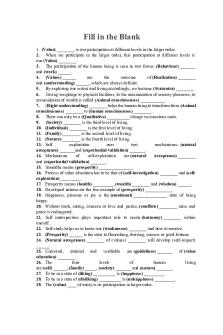
Question Bank 3question bank
- 6 Pages

Dmdw-question bank - question bank
- 17 Pages

Question bank
- 8 Pages

Question BANK
- 19 Pages
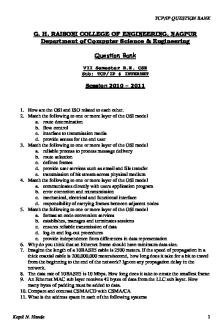
Tcp-ip-question-bank
- 25 Pages

Chapter 4 - Question Bank
- 28 Pages

DIP Question Bank Sheetal
- 14 Pages
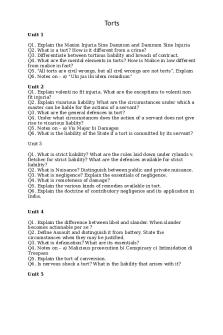
Torts Question Bank
- 2 Pages
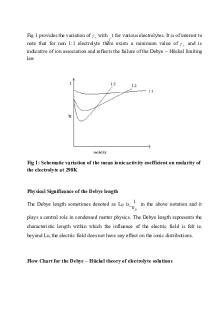
QB5 - Question Bank 5
- 104 Pages

Assessment Question Bank 1
- 22 Pages

Ch 21 test bank - Question bank
- 49 Pages
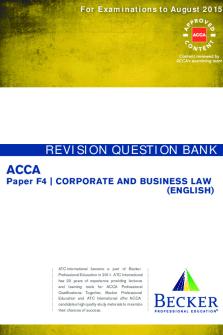
Revision Question Bank 60
- 154 Pages
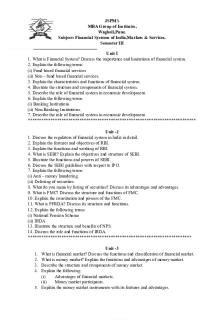
Fsims Question Bank
- 4 Pages

11. Autocad question bank
- 14 Pages
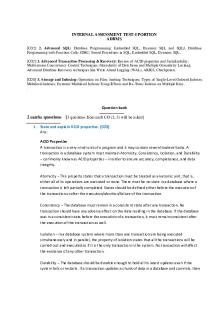
Question bank Adbms - solution
- 45 Pages

Viva Question Bank - CSS
- 17 Pages
Popular Institutions
- Tinajero National High School - Annex
- Politeknik Caltex Riau
- Yokohama City University
- SGT University
- University of Al-Qadisiyah
- Divine Word College of Vigan
- Techniek College Rotterdam
- Universidade de Santiago
- Universiti Teknologi MARA Cawangan Johor Kampus Pasir Gudang
- Poltekkes Kemenkes Yogyakarta
- Baguio City National High School
- Colegio san marcos
- preparatoria uno
- Centro de Bachillerato Tecnológico Industrial y de Servicios No. 107
- Dalian Maritime University
- Quang Trung Secondary School
- Colegio Tecnológico en Informática
- Corporación Regional de Educación Superior
- Grupo CEDVA
- Dar Al Uloom University
- Centro de Estudios Preuniversitarios de la Universidad Nacional de Ingeniería
- 上智大学
- Aakash International School, Nuna Majara
- San Felipe Neri Catholic School
- Kang Chiao International School - New Taipei City
- Misamis Occidental National High School
- Institución Educativa Escuela Normal Juan Ladrilleros
- Kolehiyo ng Pantukan
- Batanes State College
- Instituto Continental
- Sekolah Menengah Kejuruan Kesehatan Kaltara (Tarakan)
- Colegio de La Inmaculada Concepcion - Cebu